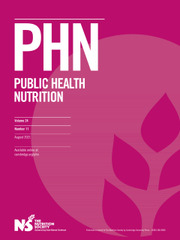Editorial
In This Issue: Ultra-processed food and health
- Part of:
-
- Published online by Cambridge University Press:
- 26 July 2021, pp. 3177-3178
-
- Article
-
- You have access
- HTML
- Export citation
Monitoring and surveillance
Research paper
Commercial foods for infants under the age of 36 months: an assessment of the availability and nutrient profile of ultra-processed foods
- Part of:
-
- Published online by Cambridge University Press:
- 12 April 2021, pp. 3179-3186
-
- Article
-
- You have access
- HTML
- Export citation
Clinically diagnosed iron and iodine deficiencies and disorders in the entire population of US military service members from 1997 to 2015
-
- Published online by Cambridge University Press:
- 05 February 2021, pp. 3187-3195
-
- Article
-
- You have access
- Open access
- HTML
- Export citation
Foods provided to children in family day care: an observational study
-
- Published online by Cambridge University Press:
- 06 April 2021, pp. 3196-3204
-
- Article
-
- You have access
- HTML
- Export citation
Assessment and methodology
Short Communication
Adverse childhood experiences and obesity over time
-
- Published online by Cambridge University Press:
- 26 April 2021, pp. 3205-3209
-
- Article
-
- You have access
- HTML
- Export citation
Nutritional status and body composition
Research paper
Optimal gestational weight gain in Chinese pregnant women by Chinese-specific BMI categories: a multicentre prospective cohort study
-
- Published online by Cambridge University Press:
- 12 April 2021, pp. 3210-3220
-
- Article
-
- You have access
- HTML
- Export citation
Impacts of lockdown on dietary patterns among youths in China: the COVID-19 Impact on Lifestyle Change Survey
-
- Published online by Cambridge University Press:
- 17 May 2021, pp. 3221-3232
-
- Article
-
- You have access
- Open access
- HTML
- Export citation
Impact of COVID-19 on child malnutrition, obesity in women and household food insecurity in underserved urban settlements in Sri Lanka: a prospective follow-up study
-
- Published online by Cambridge University Press:
- 27 April 2021, pp. 3233-3241
-
- Article
-
- You have access
- Open access
- HTML
- Export citation
Behavioural nutrition
Research paper
Applying the socio-ecological model to understand factors associated with sugar-sweetened beverage behaviours among rural Appalachian adolescents
-
- Published online by Cambridge University Press:
- 11 January 2021, pp. 3242-3252
-
- Article
-
- You have access
- Open access
- HTML
- Export citation
Review Article
A systematic review of interventions to increase breakfast consumption: a socio-cognitive perspective
-
- Published online by Cambridge University Press:
- 11 January 2021, pp. 3253-3268
-
- Article
-
- You have access
- HTML
- Export citation
Research paper
Turkish version of the ‘Three-Factor Eating Questionnaire-51’ for obese individuals: a validity and reliability study
-
- Published online by Cambridge University Press:
- 11 February 2021, pp. 3269-3275
-
- Article
-
- You have access
- Open access
- HTML
- Export citation
Effect of breakfast cereal type on portion size and nutritional implications
-
- Published online by Cambridge University Press:
- 17 February 2021, pp. 3276-3285
-
- Article
-
- You have access
- HTML
- Export citation
Household food insecurity and early childhood development in Brazil: an analysis of children under 2 years of age
-
- Published online by Cambridge University Press:
- 27 May 2021, pp. 3286-3293
-
- Article
-
- You have access
- HTML
- Export citation
Nutritional epidemiology
Research paper
Adherence to Mediterranean diet is inversely associated with the consumption of ultra-processed foods among Spanish children: the SENDO project
- Part of:
-
- Published online by Cambridge University Press:
- 23 July 2020, pp. 3294-3303
-
- Article
-
- You have access
- HTML
- Export citation
Consumption of ultra-processed foods in the third gestational trimester and increased weight gain: a Brazilian cohort study
- Part of:
-
- Published online by Cambridge University Press:
- 20 July 2020, pp. 3304-3312
-
- Article
-
- You have access
- HTML
- Export citation
Association between the consumption of ultra-processed foods and the practice of breast-feeding in children under 2 years of age who are beneficiaries of the conditional cash transfer programme, Bolsa Família
- Part of:
-
- Published online by Cambridge University Press:
- 17 August 2020, pp. 3313-3321
-
- Article
-
- You have access
- HTML
- Export citation
Ultra-processed foods and early childhood caries in 0–3‐year‐olds enrolled at Primary Healthcare Centers in Southern Brazil
- Part of:
-
- Published online by Cambridge University Press:
- 27 August 2020, pp. 3322-3330
-
- Article
-
- You have access
- HTML
- Export citation
Pro-inflammatory diet is associated with a high number of cardiovascular events and ultra-processed foods consumption in patients in secondary care
- Part of:
-
- Published online by Cambridge University Press:
- 05 November 2020, pp. 3331-3340
-
- Article
-
- You have access
- HTML
- Export citation
Early consumption of ultra-processed foods among children under 2 years old in Brazil
- Part of:
-
- Published online by Cambridge University Press:
- 23 November 2020, pp. 3341-3351
-
- Article
-
- You have access
- HTML
- Export citation
Ultra-processed foods, changes in blood pressure and incidence of hypertension: the Brazilian Longitudinal Study of Adult Health (ELSA-Brasil)
- Part of:
-
- Published online by Cambridge University Press:
- 04 March 2021, pp. 3352-3360
-
- Article
-
- You have access
- HTML
- Export citation

